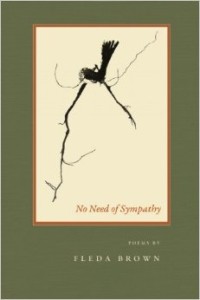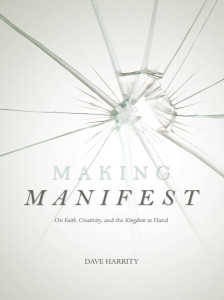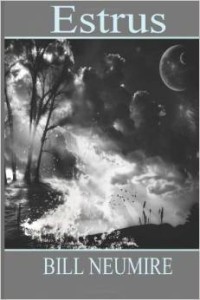Fleda Brown. No Need of Sympathy. BOA Editions, 2013. 87 pgs. $16.00.
Reviewed by Lynn Domina
All poems, I’m told, are love poems in one way or another, and the object of all love poems is really the language in which it’s written. Fleda Brown’s most recent collection, No Need of Sympathy, is all about language, and imagination, and memory, and perspective. Perhaps these four nouns ultimately refer to the same thing, but the poems in this book are characterized by a playful variety that doesn’t boil down to just one thing. The poems often develop surprisingly, as one idea leads to another and then turns back on itself, so that one sometimes continues reading just to see where these words will go. More than many contemporary poets I read, Brown relies on rhyme and received form, but she does so subtly, as if the form were almost a coincidence. She is clearly a skilled poet, and her skill is perhaps most evident in the fact that she wears it so lightly.
The collection opens with a poem called, “For, Or, Nor.” Those of us experienced in teaching basic grammar find ourselves often reciting “and, or, but, for, so, nor, yet” the list of coordinating conjunctions students may use to correct their run-on sentences. Despite their identical grammatical purpose, however, and despite our temptation to view them as mere place-holders in a sentence, the conjunctions alter the meaning of a sentence and occasionally also alter our perceptions of a speaker. Brown’s poem explores how language both reveals and forms person and persona. Here is the first stanza of the first section, “For”:
“I’m leaving you,” she said, “for you make me sick.” But
of course she didn’t say that. She thought the “for”; she admired
its elegant distance, the way it’s wedged like an iron strut
between result and cause, the way it’s almost “far,” and dire
as a raised eyebrow.
“For” is certainly among the more formal of coordinating conjunctions, and it is used in ordinary conversation much less frequently than most of the others, as the speaker recognizes. It’s formality does suggest distance. The speaker’s analysis of “for,” here is intriguing, for she initially claims to admire “its elegant distance,” as if it signals class—the sort of personality for whom “a raised eyebrow” would be “dire,” but then “it’s wedged like an iron strut”—it’s forceful, even implicitly violent. My favorite compositional detail in this stanza, though, is the inclusion of “But” at the end of the first line. It not only amplifies the insistence of “But,” but it also serves to gather in one of the conjunctions otherwise missing from the center of the poem.
The second section of the poem, “Or,” finds it controlling metaphor in Beethoven’s sixth symphony, the Pastoral, which the speaker describes according to its compilation of options: “repeat and repeat, always with variation.” The third conjunction, “Nor,” excludes rather than permits options, and this section of the poem becomes more somber. If in the first section the speaker is experimenting with persona, in the third section it’s her life rather than her personality that’s at stake:
As a flower sheds petal after petal, as further tests
strip away one after another of the last hopes for a cure,
as a person shakes into the waste bin all her cigarettes
and goes down the street not knowing who she is, the pure
air of saints is achieved by abandonment: Jesus in the garden
alone, cold moon disappearing, Buddha at the morning star,
mind emptied of its snarl of ignorance. Neither to harden
against loss, nor to welcome it. To let it be who you are.
The accumulation of choices available through “or” are absent here; choice is negated through “nor.” Through the positions of her figures of speech and allusions in this section, Brown has constructed multiple layers of meaning. Initially, it seems that the petals lost from the flower are compared to the hope lost through medical tests—and those two events are compared here—but then they both come to refer to “the pure / air of saints…achieved by abandonment.” The stanza break in this section serves as its fulcrum, as the speaker moves from hopelessness and disorientation toward acceptance and neutrality. The return to “nor” in the last line is particularly telling, for it doesn’t close off an option, exactly, as we expect “nor” to do. Yet it doesn’t exactly open itself to options either. Rather, it disengages itself from attachment to one future or another; it permits the speaker to be simply who and what she is.
The rhyme in this last stanza is particularly effective, as the “a” rhymes—garden / harden—are also near rhymes with the “b” rhymes—star / are. In fact, Brown uses similar near rhymes to fulfill the rhyme pattern in earlier stanzas, as “admired” rhymes with “dire” in stanza one and “where” rhymes with “repaired” in stanza four. The concluding stanza, therefore, functions to enclose the formal strategies Brown has chosen earlier in the poem as well as to fulfill its thematic intent.
In several of her poems, Brown incorporates multiple sources of knowledge, juxtaposing one image against another and then developing the first as metaphor for the second. This works particularly well in “Sugar, Sugar” which initially seems to be about a sugar maple, and then seems to be about the ubiquitousness of refined sugar, but ultimately reveals its central concern—a girl’s adolescent development. She experiences herself as quickened energy, like what she tastes in “Pepsi, its sugar- / fizz, and the frozen orange clouds of the Dreamsicle, the slow / caramel centers of the Milky Way…” Each of these is like “lightning up my body,” and her body is also like the tree:
…It was so far away, so far from the tip
of a tree to the ground, yet the waters traveled through the narrow
tubes and arrived from roots and leaves, and the trunk slowly
thickened with its quiescent heartwood that shored up
all the rest, that was, really, quite finished with all the rest,
that let itself be wrapped by the sugar-hyped layers, so it could
think. It was not really thinking. What was it doing,
not bothering to call itself happy or sad?
This poem is an exploration of growth and of life, obviously, but it is also an exploration of how creates meaning and invites us to accept our own meaning. Brown exploits this strategy in several other poems here, many of which are among my favorites: “The Kayak and the Eiffel Tower,” “My Father and Hemingway Go Fishing,” “The Dead,” “The Puffball.” No Need of Sympathy is a collection that is clearly contemporary and yet understands its place in tradition; it is serious without being somber, playful without defaulting to the merely clever. The poems are set in specific geographic locations and often mention individual human beings, and their particularity succeeds in that paradox we hope for from literature, in reading of another to understand ourselves, “To let it be who you are.”





